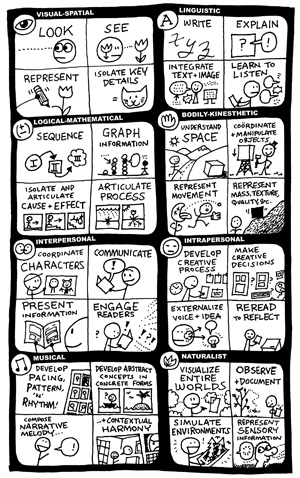
The Horn Book website has lots of material of interest to teachers. Here are some areas to explore. And follow us on Twitter: #lollysclass
|
Interviews with authors and illustrators Recommended books -- reviews and themed book lists |
School -- reading in school, author visits, and more Suggestion box: what else to you want to see in Lolly's Classroom? |
Using comics in your classroom
Last month, I was fortunate to be able to attend several sessions at the Comics and the Classroom symposium offered as part of the Massachusetts Independent Comics Expo (MICE) on October 5th.
 One of the panels from Marek Bennet's "Multiple Intelligences" sequence. http://marekbennett.com/2011/02/28/multiple-intelligences-comics-education/
One of the panels from Marek Bennet's "Multiple Intelligences" sequence. http://marekbennett.com/2011/02/28/multiple-intelligences-comics-education/Last month, I was fortunate to be able to attend several sessions at the Comics and the Classroom symposium offered as part of the Massachusetts Independent Comics Expo (MICE) on October 5th. The symposium, which was the first of what they hope will become an annual event as part of MICE, brought together a number of comics artists and educators to discuss how comics can be incorporated into the classroom at various levels.
The day started off with a session by Marek Bennett, the creator of Slovakia: Fall in the Heart of Europe, an educator who offers comics workshops for students of all ages, and is one of the Applied Cartooning Program Advisors at the Center for Cartoon Studies. The program teaches students to use cartoons and visual communications techniques in realms outside of comic books or graphic novels. He talked about the way that the styles and techniques of comics can be brought to education in all fields to make subjects more memorable, engaging, and understandable. While the program Bennett works with is aimed at graduate students pursuing a Master of Fine Arts degree, he explained how the techniques can be brought to any age group by adapting assignments to incorporate visual elements where there previously may have been only text and walked us through the Applied Cartooning Manifesto. He also displayed this approach in the form of his own visual article on Multiple Intelligences and placed the approach in a historical context that includes Trajan’s Column and the Bayeux Tapestry. A discussion afterwards with the attendees brought up several ways teachers could use these ideas to help students express emotions and advocate for social change.
The second session of the symposium was presented by Michael Gianfrancesco and covered how he teaches close reading techniques using graphic novels. He talked about how, inspired by the work of Nancy Frey and Douglas Fisher, he created a curriculum that uses graphic novels, and particularly wordless graphic novels, such as segments of Will Eisner’s New York: Life in the City, to teach students to identify what is obvious, implied and assumed in their reading of a work. Taking text out of the process helps to simplify it by paring it down to its basics but also engages students, many of whom already enjoy comics and manga. After students have worked out what is obvious, implied, and assumed in each comic, they are also prompted to think more about their assumptions, sometimes even writing stories based on what they assumed when first reading the comic. Since he teaches in Rhode Island, a state that has adopted the Common Core, Gianfrancesco has tied his curriculum in to specific sections of the Common Core and uses it with students in multiple tracks at his school. He recommended New York: Life in the City, Bottomless Belly Button by Dash Shaw, A.D.: New Orleans After the Deluge by Josh Neufeld, and Stitches by David Small as works that could be used to teach close reading in high school classes.
I also attended a panel discussion between three artists who create educational comics. Two of the artists, Jason Rodriguez and Joel Gill, have written graphic novels on historical topics that aim to educate readers and have been incorporated into classrooms. The final panelist, Cathy Leamy, works on comics that foster health literacy. Leamy discussed the field of graphic medicine which includes both comics aimed at improving health literacy by explaining complicated medical topics through visuals and comics by healthcare professionals and patients as a way of expressing their emotions. One of the highlights of this last panel was a debate between the panelists (and some members of the audience) about how to balance facts and storytelling in their works. This discussion highlighted both the difficulties that authors face in ensuring that their works are accurate, engaging, and clear and the importance that educators place on using materials in the classroom that portray facts correctly.
I found each of the sessions very interesting and useful. If you have an opportunity to attend MICE or the Comics and the Classroom symposium next year, I would highly recommend it.
RELATED
RECOMMENDED
ALREADY A SUBSCRIBER? LOG IN
We are currently offering this content for free. Sign up now to activate your personal profile, where you can save articles for future viewing.






Add Comment :-
Comment Policy:
Comment should not be empty !!!
Dan Mazur
Thanks for the great report on the symposium, which I worked on for MICE-- I'd also like to mention that the event was hosted and co- presented by the Lesley University Graduate School of Education (Lesley is the host and co-presenter of the entire Massachusetts Independent Comics Expo, in fact)! We are looking forward to building on this year's symposium in the coming years.Posted : Nov 21, 2014 07:42